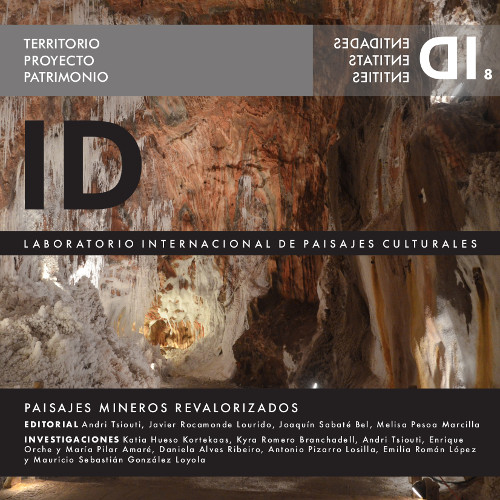GOOD PRACTICES APPLIED IN LIGNITE MINING ACTIVITY Mine restorations compatible with the environment that modify the mining landscape of Val de Ariño (Teruel)
DOI:
https://doi.org/10.5821/identidades.9043Keywords:
Mining landscape, sustainable restoration, scenery, Val de AriñoAbstract
The exploitation of lignite in the province of Teruel, has been an industrial activity of first magnitude and generator of wealth during an important period of our recent history. Thus, the so called Cuenca Oliete Norte, also known as Cuenca Andorra-Alloza-Ariño, is home to the Val de Ariño, a territory where the special characteristics of the subsoil and the terrestrial crust define a geology of special terrains that form a deposit of lignite of great proportions.
Today we observe an anthropic landscape, modified by the human activity, that has been modeled, structured, recovered, restored, where a frenzied extraction took place, plagued by subterranean and open-air mining activity. From here the coal has engraved its imprint on the landscape, as well as remains of the mines and the restorations carried out, drawings and polychromatic slopes. In the catalogue of elements or sites to be preserved selected by TICCIH-Spain, contained in the Annex V of the 2011 National Industrial Heritage Plan, the next reference is found: "The coal mines and the mining landscape of the Val de Ariño". That is a proof that the place is already considered to be of exceptional heritage value and of vital importance for the future of the area.
References
Obra completa
ALQUEZAR PENÓN, J. (coord., varios aut.) (2005). Carbón. Centro de Estudios Locales de Andorra. Graficas Sender. Zaragoza
LERMA LOSCOS, J. FABRO ESTEBAN, G. (2007). De carbón es la luz. Historia de ENCASO y ENDESA en las cuencas mineras turolenses. Fundación ENDESA. Madrid
CAÑIZARES RUIZ, M. (2004). Algunas iniciativas de turismo minero en Castilla-La Mancha. Cuadernos geográficos 34. Ciudad Real. pp (129-143)
Actas de Congresos
NICOLAU, J. M., MELLADO, I., NYSSEN, S. (2009). MinerÃa y desarrollo sostenible. Análisis ambiental de treinta años de carbón a cielo abierto en Teruel. IX Congreso Internacional sobre Patrimonio Geológico y Minero. Andorra (Teruel) 2008. Edita SEDPGYM. pp 11-24
PUCHE RIART, O. (2004). Patrimonio minero-metalúrgico español: arquitectura y paisajes mineros. IV Congreso sobre Patrimonio Geológico y Minero. Utrillas (Teruel) 2003. pp 57-68
BADIA, D. et al. (2006). Rehabilitación de taludes de minerÃa a cielo abierto con especies leñosas autóctonas: El caso de Corta Barrabasa. I Congreso Internacional de MinerÃa y Metalurgia en el contexto de la historia de la humanidad: Pasado, Presente y Futuro. Mequinenza (Zaragoza) 2006. pp 389-401
PIZARRO LOSILLA, A. (2013). Recuperación sostenible de espacios afectados por la minerÃa en la comarca Andorra-Sierra de Arcos. Valores didácticos intrÃnsecos. I Simposio Red REUSE y Seminario internacional de Reconversión de Territorios. Belo Horizonte (Brasil). 2012. pp 137-144
PIZARRO LOSILLA, A. (2014). Parque minero comarca de Andorra “MWINASâ€: Recuperación y puesta en valor de un espacio post-minero. Seminario sobre Patrimonio Minero y Sustentabilidad. Propuestas y experiencias de reutilización. Concepción (Chile). 2013. pp 258-273
Folletos Informativos
Restauración de Terrenos. Objetivos, metodologÃa y resultados en las minas a cielo abierto en la Cuenca de Teruel
El humedal de Corta Alloza, Teruel. Restauración ecológica de zonas minera. Edita ENDESA. 2003
Centro Minero Endesa Generación Andorra. ¿Cómo restaura Endesa sus explotaciones a cielo abierto? BoletÃn de cultura e información. Centro de Estudios Locales de Andorra. pp. 26-27
Downloads
Published
Issue
Section
License
Those authors who have publications with this journal, accept the following terms:
a. Authors will retain their copyright and guarantee the journal the right of first publication of their work, which will be simultaneously subject to the Creative Commons CC BY-NC-ND-4.0 recognition license that allows third parties to share the work provided that its author and its first publication are indicated in this journal, but they cannot be changed or used commercially.
b. Authors may adopt other non-exclusive license agreements for the distribution of the version of the published work (eg: deposit it in an institutional telematic archive or publish it in a monographic volume) provided that the initial publication in this journal is indicated.
c. Authors are allowed and recommended to disseminate their work through the Internet (e.g. in institutional telematic files or on their website) before and during the submission process, which can lead to interesting exchanges and increase citations. of the published work. (See The effect of open access).













